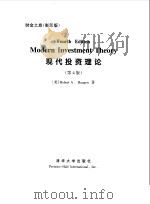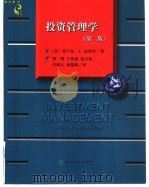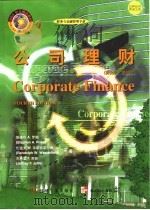《现代投资理论 英文版·第4版》
| 作者 | (美)(R.A.豪根)Robert A. Haugen著 编者 |
|---|---|
| 出版 | 北京:清华大学出版社 |
| 参考页数 | 748 |
| 出版时间 | 1999(求助前请核对) 目录预览 |
| ISBN号 | 7302034281 — 求助条款 |
| PDF编号 | 86641348(仅供预览,未存储实际文件) |
| 求助格式 | 扫描PDF(若分多册发行,每次仅能受理1册) |

PART ONE1
BACKGROUND1
1Introduction to Modern Investment Theory1
PART ONE1
BACKGROUND1
1INTRODUCTION TO MODERN INVESTMENT THEORY1
CHAPTER 1The Function of Financial Markets1
Savings-Investment Foundation1
Efficiency of Financial Markets2
THE DEVELOPMENT OF MODERN INVESTMENT THEORY2
Stages of Efficiency3
Financial Assets3
WHY SHOULD YOU LEARN MODERN INVESTMENT THEORY?4
The Role of Financial Intermediaries5
2 SECURITIES AND MARKETS6
Bank Discount Rate6
2 Securities and Markets6
Government Bonds7
SECURITIES7
Disintermediation and Securitization8
Financial Innovation9
Country Efficiency9
The Catalyst for Change10
Types of Innovations11
The Implications of Savings11
Corpotate Fixed Income Securities11
Sensitivity of Price to Various Properties12
Degrees of Moneyness13
Interest Rates and Arbitrage Efficiency14
Corporate Stock14
Summary15
Selected References15
The Structure of the System17
CHAPTER 2The Flow-of-Funds System17
Sectoring18
The Preparation of a Matrix and Its Use20
Forwrd and Futures Contracts20
Options and Warrants20
Federal Reserve Flow-of-Funds Data21
The Shares of Investment Companies and Mutual Funds22
Credit Flows23
Market Pressure to Assume Equilibrium Prices24
The Difference Between Primary and Secondary Markets24
THE FINANCIAL MARKETS24
Implications of Analysis25
Organizde Exchanges for Common Stock and Bonds25
Summary27
Organized Exchanges for Futures Contracts27
Organized Exchanges for Options27
Selected References28
The Individual Choice29
The Interest Rate in an Exchange Economy29
CHAPT ER 3Foundations for Interest Rates29
The Over-the -Counter Market30
Computerized Trading Techniques30
Optimum with Exchange31
Combined Effect33
SUMMARY34
Market Equilibrium35
3 Some Statistical Concepts38
3 SOME STATISTICAL CONCEPTS38
Behavior of Individual Economic Units39
Interest Rates in a World with Risk39
THE SIMPLE OR MARGINAL PROBABILITY DISTRIBUTION39
The Population Expected Value and Variance40
The Sample Mean and Variance40
Utility for Financial Assets40
THE JOINT PROBABILITY DISTRIBUTION42
Utility for Other Assets42
Utility for Financial Liabiliues42
The Sample Covariance43
Market Equilibrium43
Maximizing Utility for the Economic Unit44
The Action of All Economic Units45
Summary46
The Population Covariance46
Appendix:The Equilibrium Prices of Financial Assets47
The Correlation Coefficient48
Market Equilibrium:Two Economic Units50
The Coefficient of Detemination50
THE RELATIONSHIP BETWEEN A STOCK AND THE MARKET PORTFOLIO51
Market Equilibrium:Multiple Financial Assets51
The Charaeteristie Line52
The Beta Factor53
Selected References53
Residual Variance54
CHAPTER 4Prices and Yields for Bonds and Money Market Instruments55
Review of Present Values55
Present Value When Interest Is Compounded More Than Once a Year56
Annuities56
SUMMARY57
Coupons and Principal Payments57
The Price of a Bond57
Continuous Compounding57
Price When Next Coupon Payment Is Less Than Six Months Away58
Zero-Coupon Bonds60
Yield Calculations for Bonds60
Holding Period Return61
Current Yield61
Implicit Reinvestment Rate Assumption61
Yield for Perpetuilies62
Yield-to-Maturity for Zero-Coupon Bonds62
Money Market Instrument Returns63
Summary64
Implications64
Selected References65
CHAPTER 5 Inflation and Returns66
PART TWO66
PORTFOLIO MANAGEMENT66
4COMBINING INDIVIDUAL SECURITIES INTO PORTFOUOS66
The Historical Record in Brief66
4 Combining Individual Securities into Portfolios66
PORTFOLIO MANAGEMENT66
PART TWO66
THE RISK AND EXPECTED RETURN OF A PORTFOLIO68
The Portfolio s Rate of Return68
The Portfolio s Expected Rate of Return69
The Nature of Inflation Premiums69
Unanticipated Inflation70
The Portfolio s Variance70
COMBINATION LINES72
The Fisher Effect72
Nominal Interest Rates and Inflation, Theoretically73
Empirical Evidence on Nominal Interest Rates74
Problems in Empirical Testing74
Testing for the Effect of Inflation75
The Cases of Perfect Positive and Negative Correlation75
The Fisher Effect More Directly77
A Summing Up77
Nominal Contracting Effects77
Debtor-Creditor Claims78
Depreciation78
Inventories78
The Mechanics79
Inflation Indexed Bonds79
Empirical Testing79
Corporate Value79
Other Aspects80
Summary80
Borrowing and Lending at a Risk-Free Rate80
SUMMARY81
Selected References81
APPENDIX1:FORMULAS FOR THE EXPECTED RATE OF RETURN AND VARIANCE OF A PORTFOLIO82
Definition of Term Structure83
CHAPTER 6The Term Structure of Interest Rates83
The Pure Expectations Theory84
Forward Rates of Interest85
Substitutability of Maturities86
Technical Problems87
Arbitruge and Market Efficiency88
Uncertainty and Term Premiums89
Market Segmentation90
5 FINDING THE EFFICIENT SET92
Term Structure Implications92
General Equilibrium Notions92
5 Finding the Efficient Set92
Cox-Ingersoll-Ross Theory92
THE MINIMUM VARIANCE AND EFFICIENT SETS93
Other Models of the Term Structure93
Multifactor Models94
FINDING THE EFFICIENT SET WITH SHORT SELLING94
Lattice-Type Models95
The Isoexpected Return Lines96
Summary97
Empirical Evidence97
Selected References98
The Isovariance Ellipses99
The Critical Line101
The Coupon Effect101
CHAPTER 7Price Volatility, Coupon Rate, and Maturity101
The Duration Measure and Its Changing Behavior103
Relationship between Duration and Maturity105
FINDING THE MINIMUM VARIANCE WITHOUT SHORT SELLING106
Relationship between Duration and Changes in Interest Rates106
Relationship between Duration and Coupon Payment106
Volatility Duration108
Modified Duration Formula109
Convexity109
TWO IMPORTANT PROPERTIES OF THE MINIMUM VARIANCE SET109
The Convexity Measure110
Illustration of Price-Change Estimates Using Modified Duration and Convexity111
Further Observations on Convexity112
Immunization of Bond Portfolios113
Immunization with Coupon Issues114
An Illustration114
Fisher-Weil Duration116
Mapping the Stochastic Process116
Testing for Immunization Effectiveness117
Additional Immunization Considerations118
Equilibration between Coupon and Noncoupon Bond Markets118
Coupon Stripping119
SUMMARY119
Term Structure of Pure Discount Bonds120
APPENDIX2:A THREE-DIMENSIONAL APPROACH TO FINDING THE EFFICIENT SET120
Arbitrage Efficiency between the Markets120
Summary122
Selected References123
CHAPTER 8The Default-Risk Structure of Interest Rates125
Promised, Realized, and Expected Rates125
Distribution of Possible Returns126
APPENDIX3:USING LAGRANGIAN MULTIPLIERS TO FIND THE MINLMUM VARIANCE SET128
Empirical Evidence on Default Losses128
APPENDIX4:PROOF OF PROPERTY II130
Credit Ratings and Risk Premiums131
Some Studies of Bond Ratings132
Cyclical Behavior of Risk Premiums133
APPENDIX5:UTILITY AND RISK AVERSION134
The Market Segmentation Effect135
Issuers and Use in Acquisitions137
Development of the Market137
Speculative-Grade(Junk)Bonds137
Risk versus Return138
Event Risk139
Empirical Evidence141
Risk Structure and the Term Structure141
Summary143
Selected References144
Introduction to Contract146
CHAPTER 9Derivative Securities:Interest-Rate Futures146
Features of Futures Markets148
Margin Requirements148
Money Market Instruments148
Quality Delivery Options149
Longer-Term Instruments149
Marking-to-Market and Price Movements149
Hedging and Speculation151
Some Hedging Fundumentals151
Futures and Spot Prices152
Long Hedges152
6 FACTOR MODELS152
6 Factor Models152
FACTOR MODELS TO ESTIMATE VOLATILITY OF RETURN153
The Single -Factor Model153
Hedge Rations154
Short Hedges155
Basis Pisk155
The Single-Factor Model s Simplified Formula for Portfolio Variance155
More on Basis Risk156
Sources of Basis Risk158
Market Efficiency158
Possible Reasons for Deviation of Forward and Futures Rates159
Summary160
An Example Where the Single-Factor Model Works160
Selected References161
An Example of a Potential Problem with the Single-Factor Model163
CHAPTER 10Derivative Securities:Options163
Option Valuation163
Expiration Date Value of an Option164
Multifactor Models165
Valuation Prior to Expiration165
Estimating Portfolio Variance Using a Multifactor Model:An Example167
Hedging with Options168
Black -Scholes Option Model169
MODELS FOR ESTIMATING EXPECTED RETURN171
Debt Options172
Features of Futures Options172
Use of Debt Options173
Caps, Floors, and Collars174
Valuation of Debt Options175
Firm Characteristics(Factors)That Induce Differentials in Expected Returns176
Yield Curve Options177
Estimating and Projecting Factor Payoffs178
Debt Plus Option Characteristic179
Conversion Price/Ratio179
Convertible Securities179
A Test of the Accuracy of Expected Return Factor Models180
Value of Convertible Securities180
Premiums181
Simulating the Performance of the Expected Return Factor Model182
Summary183
Other Reasons for Premiums183
SUMMARY184
Appendix A:Put-Call Parity184
Appendix B:Application of Option Pricing Concepts to Valuing Convertible Securities186
Selected References190
CHAPTER 11 Derivative Securities:Swaps192
Swap Features192
An Illustration193
Valuation Issues194
Comparative Advantage194
Completing Markets195
Default Risk195
PART THREE196
7THE CAPITAL ASSET PRICING MODEL196
RISK,EXPECTED RETURN,AND PERFORMANCE MEASUREMENT196
Skirting Tax Laws and Regulations196
PART THREE196
RISK,EXPECTED RETURN,AND PERFORMANCE MEASUREMENT196
7The Capital Asset Pricing Model196
THE ASSUMPTIONS OF THE CAPITAL ASSET PRICING MODEL197
AssumptionⅠ:Investors Can Choose Between Portfolios on the Basis of Expected Return and Variance197
Credit Risk, Maturity, and Systemic Risk197
Swap Valuation:A Summing Up197
Default Provisions198
Value at Risk199
Secondary Market Values200
Assumption Ⅲ:There Are No Frictions in the Capital Market201
AssumptionⅡ:All Investors Are in Agreement Regarding the Planning Horizon and the Distributions of201
Summary201
Swaptions201
The Capital Market Line202
THE CAPITAL ASSET PRICING MODEL WITH UNLIMITED BORROWING AND LENDING AT A RISK-FREE RATE202
Selected References202
Option-Adjusted Spreads203
CHAPTER 12Embedded Options and Option-Adjusted Spreads203
An Illustration204
The Basic Methodology204
The Nature of the Call Feature205
Forms of the Provision206
The Relationship Between the Risk of an Asset and Its Expected Rate of Return206
Putable Bonds207
Redemption versus Callability207
The Call Featrure s Valuation208
The Positioning of Characteristic Lines under the Capital Asset Pricing Model208
Interest-Rate Expectations209
The Positions of Individual Assets in Expected Return, Standard Deviation Space209
The Call Feature and Convexity210
Valuation in an Option Pricing Context211
Empirical Evidence on Call Valuation212
The Sinking Fund212
Characteristics of the Provision213
Value of the Sinking Fund214
Empirical Evidence215
Summary215
Selected References216
THE CAPITAL ASSET PRICING MODEL WITH NO RISK-FREE ASSET217
CHAPTER 13Mortgage Securities and Prepayment Pisk217
Some Features of Mortgages217
Mortgage Pass-Through Security218
Agency Pass-Throughs218
Nonagency Pass-Throughs219
Mortgage Derivatives219
THE CAPITAL ASSET PRICING MODEL WHEN A RISK-FREE ASSET EXISTS BUT WE CAN T SELL IT220
Collateralized Mortgage Obligations(CMOs)220
Floaters and Inverse Floaters221
Stripped Mortgage-Backed Securities221
Planned Amortization Class(PAC)and Targeted Amorization Class(TAC)Securities221
Prepayment Option and Its Valuation222
Prepayment and Convexity222
SUMMARY222
Measures of Prepayment223
Coupon Rate and Age224
Additional Factors Explaining Prepayment225
Modeling Prepayment Experience226
Prepayment Behavior of Certain Derivatives227
Planned Amortization Class Securities227
Optiion-Adjusted Spread Approach227
Other Asset-Backed Securities230
Summary230
Selected References231
8 Empirical Tests of the Capital Asset Pricing Model232
8 EMPIRICL TESTS OF THE CAPITAL ASSET PRICING MODEL232
Risk and Return form Foreign Investment233
The Black Jensen, and Scholes Test(1972)233
CHAPTER 14Controlling Currency Risk233
EARLY TESTS OF THE CAPITAL ASSET PRICING MODEL233
Exchange Rate Risk Management234
Forward Exchange Market235
The Fama-MacBeth Study(1974)235
Illustration of Spot and Forward Exchage Rates236
A Single European Currency(Euro)236
Underlying Relationships238
The Law of One Price238
Purchasing Power Parity238
ROLL S CRITIQUE OF TESTS OF THE CAPITAL ASSET PRICING MODEL238
Previous Tests as Tautologies239
Interest -Rate Parity240
Interest-Rate Parity Approximation242
Covered Interest Arbitrage242
Can the Capital Asset Pricing Model Ever Be Tested?243
Empirical Evidence Concerning Interest-Rate Parity(IRP)243
Currency Options244
Currency Futures244
Other Ways to Shift Risk244
Currency Swaps245
THE OTHER SIDE OF THE ISSUE245
Tautologies Can t Prediet the Future245
Valuation Implications246
Currency/Interest-Rate Swaps246
Can You Reject the CAPM if You Find No Efficient Portfolios with Positive Portfolio Weights?247
The Amount to Hedge248
The Cost of Curreucy Hedging248
Sensitivity Analysis to Alernative Market Indices248
MORE RECENT TESTS OF THE CAPM248
Testing a Contained CAPM248
Black s Universal Hedging249
Closing Thoughts249
Currency-Option and Multiple-Currency Bonds250
Some Institutional Characteristics250
Euro and Foreign Bonds250
Summary251
Selected References252
SUMMARY254
CHAPTER 15The Influence of Taxes254
Tax Treatment of Capital Gains255
Original Issue Discount(OID)Bonds255
Capital Gains Treatment for Taxable Coupon Bonds256
The De Minimis Rule257
Capital Gains Treatment for Municipal Bonds257
Tax Timing Options257
9 The Arbitrage Pricing Theory258
9 THE ARBITRAGE PRICING THEORY258
Municipal Bonds and the Taxation of Interest Income258
The Nature of the Municipal Market259
Taxable versus Tax-Exempt Yields259
DERIVING THE ARBITRAGE PRICING THEORY259
The APT with an Infinite Number of Securities260
Value of the Tax Exemption Feature261
Variation of Implied Tax Rate262
The Effect of Tax Reform and Supply263
Implied Tax Rate and Maturity263
Preferred-Stock Taxt Effects264
Straight Preferred-Stock Investments264
Auction-Rate Preferred Stock265
The APT with a Finite Number of Securities265
Summary266
Selected References266
EMPIRICAL TESTS OF THE APT267
Intial Empirical Tests267
The Issues Involved268
CHAPTER 16The Social Allocation of Capital268
Is the APT Testable in Principle?268
Ceilings on Borrowing Costs269
The Effect of Usury Laws270
THE CONSISTENCY OF THE APT AND THE CAPM270
The Negatives of Interest-Rate Ceilings271
SUMMARY271
Government Guarntees and Insurance272
The Transfer of Underlying Risk273
Interest-Rate Subsidies274
Option-Pricing Valuation274
The Effect of the Subsidy274
Effectiveness of the Subsidy275
Financial Intermediation Through Borrowing and Relending276
The Situation Illustrated277
Regulations Affecting Investor and Borrowet Behavior278
The Effect of Government Intermediation278
The Effectiveness of This Approach279
The Costs to Society279
Qualificatiion for Tax-Exempt Financing280
10 THE TRACKING POWER OF MARKOWITZ PORTFOLIO OPTIMIZATION281
10 The Tracking Power of Markowitz Portfolio Optimization281
Policy Implications281
Benefits, Costs, and Externalities281
CONDITIONS REQUIRED FOR THE EFFICIENCY OF CAP-WEIGHTED PORTFOLIOS282
WHEN CAP-WEIGHTED PORTFOLIOS ARE EFFICIENT282
Summary283
Selected References284
WHEN CAP-WEIGHTED PORTFOLIOS ARE INEFFICIENT284
What If We Disagree?284
Index285
What If Some of Us Can t Sell Short?285
Tax Avoidance286
Foreign Investors287
Human Capital287
The Benefits of Portfolio Optimization287
Interest Only(IOs), Principal Only (POs), and Residual Class Securities288
A SIMPLE TEST OF THE EFFICIENCY OF THE CAP-WEIGHTED INDEX288
TRACKING TARGETS WITH STOCK PORTFOLIOS291
Tracking Targets with Factor Models293
Tracking a Target with the Markowitz Bullet294
TRACKING THE RATE OF INFLATION WITH THE MARKOWITZ BULLET297
SUMMARY299
APPENDIX 6:FINDING THE PORTFOLIO WITH THE MINIMUM VOLATILITY OF DIFFERENCES300
11Measuring Portfolio Performance305
11 MEASURING PORTFOLIO PERFORMANCE305
MEASURING THE RATE OF RETURN TO A PORTFOLIO306
THE NEED FOR RISK-ADJUSTED PERFORMANCE MEASURES307
RISK-ADJUSTED PERFORMANCE MEASURES BASE D ON THE CAPITAL ASSET PRICING MODEL309
The Jensen Index311
The Treynor Index314
The Sharpe Index315
Misspecifying the Market Pricing Structure317
PITFALLS IN MEASURING PERFORMANCE WITH THE JENSEN, TREYNOR, AND SHARPE INDICES317
Misspecification of the Market Index321
MEASURING PERFORMANCE USING THE ARBITRAGE PRICING THEORY324
MEASURING PERFORMANCE WITHOUT THE USE OF AN ASSET PRICING MODEL327
SUMMARY330
PART FOUR341
INTEREST RATES AND BOND MANAGEMENT341
PART FOUR341
INTEREST RATES AND BOND MANAGEMENT341
12The Level of Interest Rates341
12 THE LEVEL OF INTEREST RATES341
THE REAL AND NOMINAL RATES OF INTEREST342
INTEREST RATES AND THE SUPPLY AND DEMAND FOR MONEY343
The Transactions Demand for Money343
The Speculative Demand for Money344
The Total Demand for Money346
The Supply of Money and the Equilibrium Interest Rate348
INVESTMENT, SAVING, AND NATIONAL INCOME350
THE INTEREST RATES353
A Tax Cut355
THE EFFECT OF A CHANGE IN FISCAL POLICY355
Monetizing the Deficit359
SUMMARY360
13 THE TERM STRUCTURE OF INTEREST RATES367
13 The Term Structure of Interest Rates367
THE NATURE AND HISTORY OF THE TERM STRUCTURE368
DRAWING THE TERM STRUCTURE371
METHODS OF COMPUTING THE YIELD TO MATURITY375
The Arithmetie Mean Yield to Maturity375
The Geometric Mean Yield to Matruity376
The Internal Yield to Maturity376
A BRIEF OVERVIEW OF THE THREE THEORIES OF THE TERM STRUCTURE376
THE MARKET EXPECTATIONS THEORY OF THE TERM STRUCTURE377
THE LIQUIDITY PREFERENCE THEORY OF THE TERM STRUCTURE380
THE MARKET SEGMENTATION THEORY OF THE TERM STRUCTURE383
DERIVING THE MARKET S ORECAST OF FUTURE INTEREST RATES FROM THE TERM STRUCTURE386
Finding the Market s Forecast from Arithmetic Mean Yields386
Finding the Market s Forecast with Internal Yields388
SUMMARY392
APPENDIX 7:AVERAGING MULTIPLE RATES OF RETURN393
14 Bond Portfolio Management407
14 BOND PORTFOLIO MANAGEMENT407
ESTIMATING THE EXPECTED RETURN OF A BOND FOR PORTFOLIO ANALYSIS408
Forecasting Expected Returns on Treasury Bonds408
Forecasting Expected Returns on Corporate Bonds411
A DURATION-BASED APPROACH TO ESTIMATING THE RISK OF A BOND PORTFOLIO413
A MARKOWITZ APPROACH TO BOND RISK MANAGEMENT414
DIVIDING THE PORTFOLIO BETWEEN BONDS AND STOCK416
SUMMARY416
15 INTEREST IMMUNIZATION422
15 Interest Immunization422
CASH MATCHING AND INTEREST IMMUNIZATION423
ALTERNATIVE MEASURES OF DURATION425
Macaulay s Duration425
Fisher-Weil Duration426
Duration and Yield Elasticity426
Duration and the Response of the Value of a Stream of Payments or Receipts to a Change in Discount R427
Cox, Ingersoll, Ross Duration430
IMMUNIZING WITH MACAULAY S DURATION:THE CASE OF A SINGLE-PAYMENT LIABILITY431
The Effect of Interest Rate Changes on Present Values432
The Effect of Interest Rate Changes on Terminal Values433
COMPUTING THE MACAULAY DURATION AND INTERNAL YIELD OF A BOND PORTFOLIO435
Combination Lines for Internal Yield and Duration439
IMMUNIZING WITH THE MACAULAY DURATION:THE CASE OF A MULTIPLE-PAYMENT LIABILITY439
A TEST OF THE RELATIVE EFFECTIVENESS OF THE THREE DURATION MEASURES441
SUMMARY445
16 EUROPEAN OPTION PRICING454
THE PRICING OF DERIVATIVE SECURITIES454
16European Option Pricing454
PARY FIVE454
PART FIVE454
THE PRICING OF DERIVATIVE SECURITIES454
PRICING OPTIONS UNDER RISK NEUTRALITY AND UNIFORM PROBABILITY DISTRIBUTIONS455
Valuing a Call Option455
Valuing a Put Option457
The Relationship Between Option Values and Stock Values459
The Effect of a Change in Stock Variance on Option Values463
BINOMIAL OPTION PRICING465
Binomial Call Option Pricing over a Single Period466
Binomial Put Option Pricing over a Single Period469
Binomial Option Pricing over Multiple Periods470
VALUING OPTIONS USING THE BLACK-SCHOLES FRAMEWORK474
The Black-Scholes Value for a Call Option478
Estimating the Variance of the Stock sReturn481
The Relationship Between Black-Scholes Put and Call Values and Underlying Stock Pritces482
The Black-Scholes Value for a Put Option482
PUT-CALL PARITY484
Using the Black-Scholes Framework to Value Options on Stocks That Pay Dividends484
APPENDIX 8:PROOF THAT αVc/αVs IS THE PROBABILITY OF EXERCISE FOR A CALL OPTION ON A STOCK WITH A487
SUMMARY487
17AMERICAN OPTION PRICING497
17 American Option Pricing497
THE LOWER LIMITS TO THE VALUE OF AMERICAN OPTIONS498
Market forces Supporting the Hard Floor498
Floors Supporting American Call Options498
Market Forces Supporting the Soft Floor499
Floors Supporting American Put Options501
When the Right to Exercise Early Has No Value502
THE VALUE OF EARLY EXERCISE502
How Dividend Payments May Induce Early Exercise of American Call Options503
Early Exercise of American Put Options504
THE BINOMIAL MODEL AS AN AMERICAN OPTION-PRICING MODEL504
SUMMARY506
APPENDIX 9:THE GESKEROLL-WHALEY AMERICAN OPTION-PRICING MODEL507
18 Additional Issues in Option Pricing512
18 ADDITIONAL ISSUES IN OPTION PRICING512
USING THE OPTION-PRICING FORMULAS TO FIND THE MARKET S ESTIMATE OF THE STOCK S VARIANCE513
BIAS PROBLEMS IN OPTION-PRICING MODELS514
Changing Volatility as a Source of Bias in Option-Pricing Models516
Bias from Using European Models to Value American Options518
Pricing Bias Resulting from Error in the Model s Inputs519
OPTION STRATEGIES520
The Straddle520
The Butterfly Spread522
Computing the Expected Return on an Option Strategy523
Delta, Gamma, and Theta524
Getting Delta Neutral526
Portfolio Insurance530
COMPLEX SECURITIES AS PORTFOLIOS OF OPTIONS533
Common Stock as an Option533
Bonds as Portfolios of Options and Option Complements535
SUMMRY536
19 Financial Forward and Futures Contracts541
19 FINANCIAL FORWARD AND FUTURES CONTRACTS541
CHARACTERISTICS OF FORWARD AND FUTURES CONTRACTS542
THE DETERMINATION OF FORWARD PRICES543
The Relationship Between the Forward Price and the Current Commodity Price544
The Relationship Between the Forward Price and the Expected Commodity Price548
The Consistency of the Two Expressions for the Forward Price551
Market Value of Previously Issued Forward Contracts552
DETERMINATION OF FUTURES PRICES553
The Sign of the Premiums for Various Financial Futures556
The Significance of the Premiums to Investors and Financial Managers556
THE SECURITY UNDERLYING A FUTURES CONTRACT TO BUY TREASURY BONDS557
HEDGING WITH BOND FUTURES CONTRACTS562
USES OF STOCK INDEX FUTURES563
FULL COVARIANCE APPROACH TO CONSTRUCTING A FUTURES OVERLAY564
SUMMARY566
ISSUES IN INVESTMENT MANAGEMENT573
PART FIVE573
20The Effect of Taxes on Investment Strategy and Securities Prices573
ISSUES IN INVESTMENT MANGEMENT573
20THE EFFECT OF TAXES ON INVESTMENT STRATEGY AND SECURITIES PRICES573
PART SIX573
THE TAX STRUCTURE574
What Investment Income Is Taxed?574
Capital Gains and Losses575
TAXES AND INVESTMENT STRATEGY575
Computing After-Tax Rates of Return575
The Locked-In Effect577
Dividend Clienteles579
THE EFFECT OF TAXES ON SECURITIES PRICES581
The Effiect of Dividends on Expected Stock Returns581
Relative Expected Returns on Taxable and Tax-Exempt Securities584
SUMMARY587
21STOCK VALUATION594
21 Stock Valuation594
A FRAMEWORK FOR VALUING COMMON STOCKS595
Dividends versus Earnings596
The Constant Growth Model596
The Multistage Growth Model597
COMPUTERIZED THREE-STAGE STOCK VALUATION601
PRICE-EARNINGS RATIO607
What Determines the Level of the Price-Earnings Ratio?608
Changes That Can Be Expected in the Price-Earnings Ration over Time608
SUMMARY609
22 Issues in Estimating Future Earnings and Dividends612
22 ISSUES IN ESTIMATING FUTURE EARNINGS AND DIVIDENDS612
PAYING IN ADVANCE FOR GROWTH613
THE LINK BETWEEN GROWTH AND STOCK VALUATION AND RISK AND EXPECTED RETURN619
THE ACCURACY OF PREDICTIONS OF GROWTH IN EARNINGS AND DIVIDENDS623
Is Past Growth a Reliable Guide to Future Growth?623
The Accuracy of Short-Term Professional Forecasts625
The Accuracy of Growth Forecasts Made by Protessional Analysts625
The Accuracy of Long-Term Professional Forecasts628
The Accuracy of Market Forecasts of the Growth in Earnings Per Share629
IMPLICATIONS FOR INVESTMENT STRATEGY634
SUMMARY637
23 Market Efficiency:The Concept641
23 MARKET EFFICIENCY:THE CONCEPT641
FORMS OF THE EFFICIENT MARKET HYPOTHESIS642
THE SIGNIFICANCE OF THE EFFICIENT MARKET HYPOTHESIS645
RISK AND EXPECTED RETURN IN AN EFFICIENT MARKET647
QUICK AND ACCURATE RESPONSE TO NEW INFORMATION650
SYSTEMATIC PATTERNS IN STOCK PRICES RELATED ONLY TO TIME-VARYING INTEREST RATES AND RISK PREMIA651
FAILURE OF SIMULATED TRADING STRATEGIES653
MEDIOCRITY IN THE PERFORMANCE OF INFORMED INVESTORS655
SUMMARY656
24 MARKT EFFICIENCY:THE EVIDENCE661
24 Market Efficiency:The Evidence661
Measuring Stock Price Response662
DO SECURITY PRICES RESPOND RAPIDLY AND ACCURATIELY TO THE RECEIPT OF NEW INFORMATION?662
The Response of Stock Prices to the Announcement of a Stock Split665
The Pesponse of Stock Prices to Quarterly Earnings Reports667
Further Evidence on the Reaction of Stock Prices to Positive and Negative Events669
THE BEHAVIOR OF CHANGES IN STOCK PRICES673
Studies of Serial Correlation673
Studies of Seasonality677
The Day-of-the -Week Effect677
DO TRADING RULES FAIL UNDER SIMULATION?693
SUMMARY710
APPENDIX10:ADDITIONAL PROPERTIES OF THE MINIMUM VARIANCE SET718
Appendix10:Additional Properties of the Minimum Variance Set718
Appendix11:Invest Software727
APPENDIX11:INVEST SOFTWARE727
Glossary729
GLOSSARY729
Index737
INDEX737
1999《现代投资理论 英文版·第4版》由于是年代较久的资料都绝版了,几乎不可能购买到实物。如果大家为了学习确实需要,可向博主求助其电子版PDF文件(由(美)(R.A.豪根)Robert A. Haugen著 1999 北京:清华大学出版社 出版的版本) 。对合法合规的求助,我会当即受理并将下载地址发送给你。
高度相关资料
-

- 投资管理学 第2版
- 1999 北京:经济科学出版社
-

- 投资学 第4版=INVESTMENTS
- 2020
-

- 投资分析与管理 英文版·第5版 英文版
- 1998 北京:机械工业出版社
-

- 透视信息高速公路革命
- 1998 海口:海南出版社
-

- 会计理论 英文版 第4版
- 1998 沈阳:东北财经大学出版社
-

- 投资管理基础 英文版 第5版
- 1998 沈阳:东北财经大学出版社;McGraw-Hill出版公司
-

- 现代投资理论分析
- 1994 合肥:安徽教育出版社
-

- 公司理财 英文版·第4版
- 1998 北京:机械工业出版社
-

- 现代投资管理
- 1994 沈阳:辽宁人民出版社
-

- 现代企业投资理论
- 1998 武汉:武汉测绘科技大学出版社
-

- 青岛投资指南 1989 英文版
- 1988.01 青岛市:青岛出版社
-

- 当代财务管理 英文版 第7版
- 1998 沈阳:东北财经大学出版社
-

- 市场学 英文版 第4版
- 1998 沈阳:东北财经大学出版社
-

- 投资学 第4版 英文版
- 1999 北京:机械工业出版社
-

- 中国投资指南 第4版
- 1989 北京:中信出版社
提示:百度云已更名为百度网盘(百度盘),天翼云盘、微盘下载地址……暂未提供。➥ PDF文字可复制化或转WORD